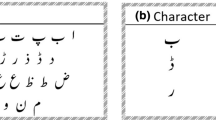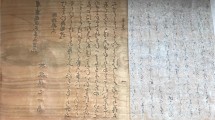Abstract
The Bengali language is based on a set of symbols for basic characters, modifiers, compound characters, and numerals. The recognition rates of handwritten basic characters and numerals are very high. However, the recognition rates of compound characters and modifiers are still poor. This might be due to their large class size with huge writing styles, much similarity, and unavailability of sufficient data for deep learning. In fact, there are some compound characters which appear very rare in practice. A proper selection of frequently used characters may reduce class size, and hence improving the accuracy. In this study, we performed a statistics on the frequency of compound characters, we developed two datasets for modifiers and compound characters, and finally we proposed a heterogeneous deep learning model (RATNet) for characters recognition. A statistics was performed on two daily Bengali newspapers, and characters with frequency ≥ 5% were selected. The handwriting of selected characters was collected from 130 writers of different ages and professions. The performance of RATNet model was evaluated on the proposed datasets and also three other existing datasets (i.e., ISI, CMATERdb, BanglaLekha-Isolated). In addition, the performance of RATNet was also compared with LeNet-5, VGG-16, ResNet-50, and DenseNet-121 models. We selected 87 out of 107 compound characters. The proposed RATNet model outperforms other models providing 99.66%, 99.27%, 98.78%, and 97.70% accuracy, respectively for the recognition of numerals, basic characters, modifiers, and compound characters on the CMATERdb dataset while keeping the number of parameters relatively low likely due to layer heterogeneity.





Similar content being viewed by others
References
Akhand M, Rahman MM, Shill P et al (2015) Bangla handwritten numeral recognition using convolutional neural network. In: Proceeding of the international conference on electrical engineering and information communication technology, Dhaka, Bangladesh, pp 1–5
Akhand MAH, Ahmed M, Rahman MMH (2016) Multiple convolutional neural network training for Bangla handwritten numeral recognition. In: Proceeding of the international conference on computer and communication engineering, San Francisco, Canada, pp 311–315
Ali AAA, Suresha M (2019) A novel features and classifiers fusion technique for recognition of arabic handwritten character script. SN Appl Sci 1(10):1286
Alom MZ, Sidike P, Taha TM et al (2017) Handwritten Bangla digit recognition using deep learning. arXiv:170502680
Alom MZ, Sidike P, Hasan M et al (2018) Handwritten Bangla character recognition using the state-of-the-art deep convolutional neural networks. Comput Intel Neurosc. arXiv:1712.09872:315-320
Amin MS, Yasir SM, Ahn H (2020) Recognition of pashto handwritten characters based on deep learning. Sensors 20(20):5884
Ba J, Mnih V, Kavukcuoglu K (2014) Multiple object recognition with visual attention. arXiv:14127755
Basu S, Das N, Sarkar R et al (2009) A hierarchical approach to recognition of handwritten Bangla characters. Pattern Recognit 42(7):1467–1484
Bhattacharya U, Chaudhuri BB (2009) Handwritten numeral databases of Indian scripts and multistage recognition of mixed numerals. IEEE Trans Pattern Anal Mach Intell 31(3):444–457
Bhattacharya U, Shridhar M, Parui SK et al (2012) Offline recognition of handwritten Bangla characters: An efficient two-stage approach. Pattern Anal Appl 15(4):445–458
Bhowmik TK, Ghanty P, Roy A et al (2009) SVM-Based hierarchical architectures for handwritten Bangla character recognition. Int J Doc Anal Recogn 12(2):97–108
Biswas M, Islam R, Shom GK et al (2017) Banglalekha-isolated: A comprehensive Bangla handwritten character dataset. arXiv:170310661
Breuel TM, Ul-Hasan A, Al-Azawi MA et al (2013) High-performance ocr for printed english and fraktur using lstm networks. In: 2013 12th international conference on document analysis and recognition, pp 683–687
Chatterji SK (2002) The origin and development of the Bengali language. Indogermanische Forschungen 47(1):370–380
Chaudhuri B, Pal U (1998) A complete printed Bangla OCR system. Pattern Recognit 31(5):531–549
Das N et al (2012) Sarkar a genetic algorithm based region sampling for selection of local features in handwritten digit recognition application. Appl Soft Comput 12(5):1592–1606
Das N, Basu S, Sarkar R et al (2009) Handwritten bangla compound character recognition: Potential challenges and probable solution. In: Procedding of the international joint conference on artificial intelligence, pp 1901–1913
Das N, Das B, Sarkar R et al (2010) Handwritten Bangla basic and compund characters recogntion using MLP and SVM classifiers. J Comput 2(2):109–115
Das N, Acharya K, Sarkar R, et al. (2014) A benchmark image database of isolated Bangla handwritten compound characters. Int J Doc Anal Recogn 17:413–431. https://doi.org/10.1007/s10032-014-0222-y
Fardous A, Afroge S (2019) Handwritten isolated Bangla compound character recognition. In: Procedding of the international conference on electrical, computer and communication engineering (ECCE), Cox’sBazar, Bangladesh, pp 1–5
Gruber I, Hlaváč M, železnỳ M, et al. (2017) Facing face recognition with resnet: round one. In: Procedding of the international conference on interactive collaborative robotics, Hatfield, Hertfordshire, UK, pp 67–74
Hariharan B, Arbeláez P, Girshick R et al (2015) Hypercolumns for object segmentation and fine-grained localization. In: Proceedings of the IEEE conference on computer vision and pattern recognition, Boston, Massachusetts, pp 447–456
He K, Zhang X, Ren S et al (2015) Deep residual learning for image recognition. CoRR arXiv:abs/1512.03385
Huang G, Liu Z, Van Der Maaten L et al (2017) Densely connected convolutional networks. In: Proceedings of the IEEE conference on computer vision and pattern recognition, Honolulu, HI, USA, pp 4700–4708
Kingma DP, Ba J (2014) Adam: A method for stochastic optimization. arXiv:14126980
LeCun Y, Bottou L, Bengio Y, et al. (1998) Gradient-based learning applied to document recognition. Proc IEEE 86(11):2278–2324
McHugh ML (2012) Interrater reliability: The kappa statistic. Biochemia Medica 22(3):276–282
Mnih V, Heess N, Graves A et al (2014) Recurrent models of visual attention. In: Procedding of the advances in neural information processing systems, Montreal Convention Centre, Canada, pp 2204–2212
Modhej N, Bastanfard A, Teshnehlab M, et al. (2020) Pattern separation network based on the hippocampus activity for handwritten recognition. IEEE Access 8:212,803–212,817
Pal U, Wakabayashi T, Kimura F (2007) Handwritten Bangla compound character recognition using gradient feature. In: Procedding of the international conference on information technology (ICIT), Orissa, India, IEEE, pp 208–213
Park J, Woo S, Lee JY et al (2018) BAM: Bottleneck attention module. arXiv:180706514
Purnamawati S, Rachmawati D, Lumanauw G et al (2018) Korean letter handwritten recognition using deep convolutional neural network on android platform. In: Journal of Physics: Conference Series
Rabby ASA, Haque S, Islam S, et al. (2018) Bornonet: Bangla handwritten characters recognition using convolutional neural network. Procedia Comput Sci 143:528–535
Racki D, Tomazevic D, Skocaj D (2018) A compact convolutional neural network for textured surface anomaly detection. In: Procedding of the IEEE winter conference on applications of computer vision, lake tahoe, NV, USA, pp 1331–1339
Rahman MM, Akhand MAH, Islam S et al (2015) Bangla handwritten character recognition using convolutional neural network. International Journal of Image, Graphics and Signal Processing 7(8):42–49
Rahman MM, Islam MS, Sassi R, et al. (2019) Convolutional neural networks performance comparison for handwritten Bengali numerals recognition. SN Appl Sci 1(12):1660
Rownak AF, Rabby MF, Ismail S et al (2016) An efficient way for segmentation of bangla characters in printed document using curved scanning. In: 2016 5th international conference on informatics, electronics and vision (ICIEV), pp 938–943. https://doi.org/10.1109/ICIEV.2016.7760138
Roy S, Das N, Kundu M, et al. (2017) Handwritten isolated Bangla compound character recognition: A new benchmark using a novel deep learning approach. Pattern Recognit Lett 90:15–21
Saufi MM, Zamanhuri MA, Mohammad N et al (2018) Deep learning for roman handwritten character recognition. International Journal of Electrical Engineering and Computer Science 12(2):455–460
Sazal MMR, Biswas SK, Amin MF et al (2014) Bangla handwritten character recognition using deep belief network. In: Procedding of the international conference on electrical information and communication technology, Dhaka, Bangladesh, pp 1–5
Shopon M, Mohammed N, Abedin MA (2016) Bangla handwritten digit recognition using autoencoder and deep convolutional neural network. In: Procedding of the international workshop on computational intelligence (IWCI), pp 64–68
Shopon M, Mohammed N, Abedin MA (2017) Image augmentation by blocky artifact in deep convolutional neural network for handwritten digit recognition. In: Procedding of the IEEE international conference on imaging, vision & pattern recognition, Himeji, Japan, pp 1—6
Simonyan K, Zisserman A (2014) Very deep convolutional networks for large-scale image recognition. arXiv:14091556
Tsai C (2016) Recognizing handwritten japanese characters using deep convolutional neural networks. University of Stanford in Stanford, California, pp 405–410
Wang F, Jiang M, Qian C et al (2017) Residual attention network for image classification. In: Proceedings of the IEEE conference on computer vision and pattern recognition, Honolulu, HI, USA, pp 3156–3164
Wikipedia contributors (2020) List of languages by number of native speakers — Wikipedia, the free encyclopedia. https://en.wikipedia.org/w/index.php?title=List_of_languages_by_number_of_native_speakers&oldid=978856845, [Online; accessed 9-October-2020]
Woo S, Park J, Lee JY et al (2018) CBAM: Convolutional block attention module. In: Proceedings of the European conference on computer vision, Munich, Germany, pp 3–19
Zhang Y (2015) Deep convolutional network for handwritten chinese character recognition. Computer Science Department, Stanford University
Acknowledgments
We thankfully acknowledge the contribution of those volunteers, who participated in writing the characters. We are grateful to Prof. Dr. Ujjal Bhattacharya, Indian Statistical Institute for providing the ISI handwritten numeral dataset. We are also grateful to the University Grants Commission (UGC) of Bangladesh and the authority of Islamic University, Kushtia-7003, Bangldesh for providing partial financial support to develop this dataset.
Author information
Authors and Affiliations
Corresponding author
Ethics declarations
Conflict of Interests
The authors declare that they have no conflict of interest.
Additional information
Publisher’s note
Springer Nature remains neutral with regard to jurisdictional claims in published maps and institutional affiliations.
Rights and permissions
About this article
Cite this article
Islam, M.S., Rahman, M.M., Rahman, M.H. et al. RATNet: A deep learning model for Bengali handwritten characters recognition. Multimed Tools Appl 81, 10631–10651 (2022). https://doi.org/10.1007/s11042-022-12070-4
Received:
Revised:
Accepted:
Published:
Issue Date:
DOI: https://doi.org/10.1007/s11042-022-12070-4




